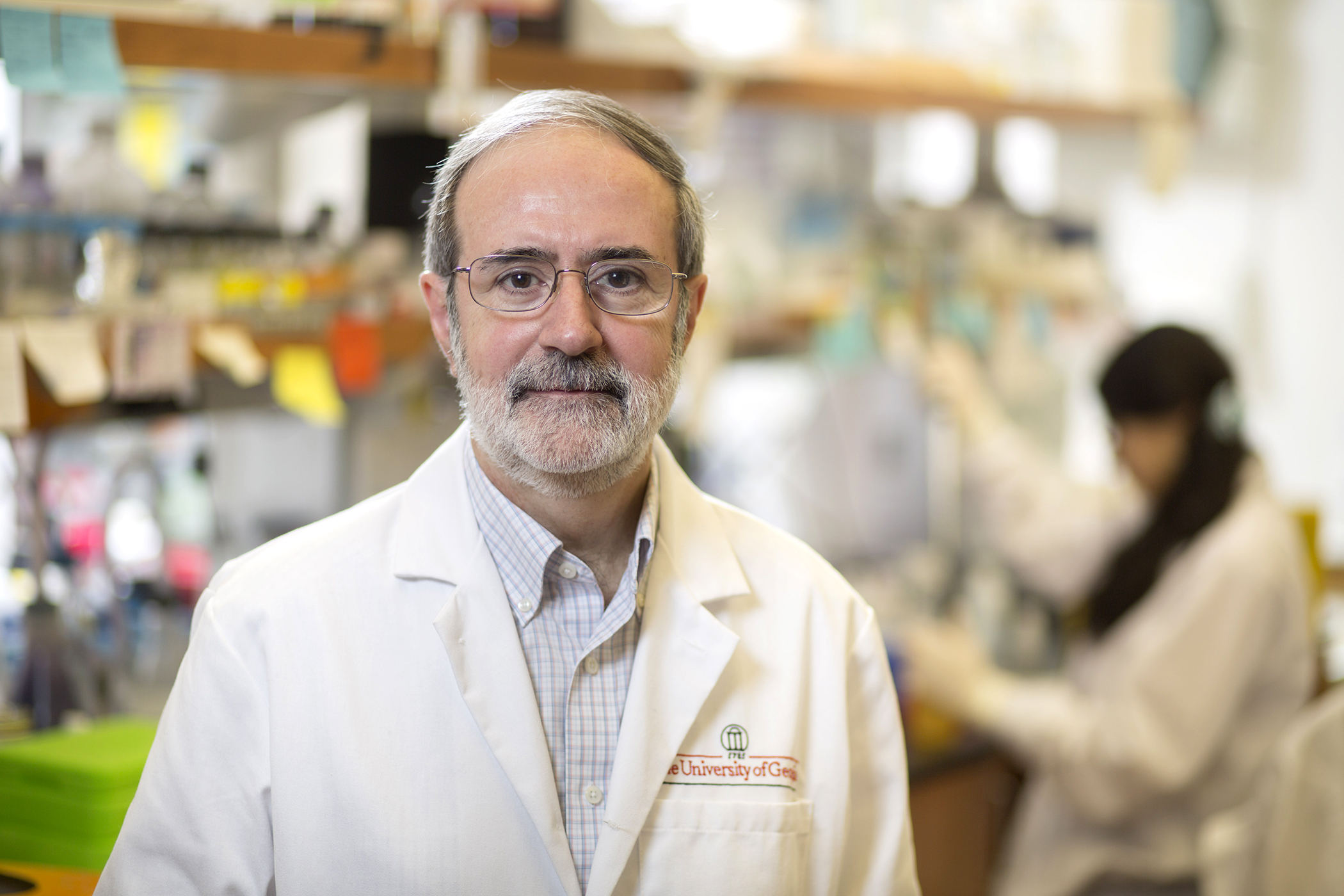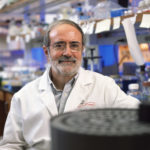Roberto Docampo

Of Note
- Editor-in-Chief, Journal of Eukaryotic Microbiology (2012-present); Member of the Editorial Board of Molecular and Biochemical Parasitology (1983-present), Experimental Parasitology (2005-present), Antimicrobial Agents and Chemotherapy (2008-present), and ACS Infectious Diseases (2014-2016); Editor of The Biochemical Journal (2005-2014); Associate Editor of The Journal of Eukaryotic Microbiology (2004-2012); Guest Editor of Acta Tropica (2002-2005), Microscopy and Microanalysis (2004), Experimental Parasitology (2008), and Essays in Biochemistry (2011).
- Member of Faculty of 1000 (2006-present)
- Member (corresponding), Brazilian Academy of Sciences (elected in 1999)
- Burroughs Wellcome Fund New Initiatives in Malaria Research Award (1999-2001)
- Burroughs Wellcome Fund/American Society for Microbiology Visiting Professor in the Microbiological Sciences (2000-2001)
- Member, Georgia Academy of Eminent Scholars (elected in 2005)
- Fellow of the American Academy of Microbiology (elected in 2010)
- Fellow of the American Association for the Advancement of Science (elected in 2011)
- Raíces (Roots) Award, Ministry of Science, Technology and Productive Innovation, Argentina (2013)
- Doctor Honoris Causa, National University of San Martin (UNSAM), Argentina (2013)
- São Paulo Excellence Chair, São Paulo Research Foundation (FAPESP), Brazil (2014)
- Distinguished Research Professor UGA (2016)
- Southeastern Conference Faculty Achievement Award, UGA (2017)
- Member (corresponding), Latin American Academy of Sciences (elected in 2017)
Research
The Docampo Laboratory has a long-term interest in the chemotherapy of parasitic diseases. Early work on free radical metabolism led to the findings that antifungal azoles are effective agents against Trypanosoma cruzi, and that the mode of action and toxicity of the nitro compounds currently used against these parasites involved free radical intermediates.
The lab interest shifted in the early 1990’s to the study of calcium homeostasis in parasitic protists. These studies led to the discovery of the acidocalcisomes, acidic organelles rich in calcium and phosphorus that are conserved from bacteria to man. For the last few years, the lab has focused on the functions of these organelles in a variety of cells, including trypanosomatids, malaria parasites, Chlamydomonas, Dictyostelium, bacteria, human platelets, mast cells, and insect, chicken, and sea urchin eggs.
The Docampo lab also found that acidocalcisomes are rich in pyrophosphate and short- and long-chain polyphosphate and that polyphosphate has a variety of novel functions in eukaryotes, from an osmoregulatory function in trypanosomes to a potent procoagulant and antifibrinolytic action in human blood. The discovery of high levels of pyrophosphate in the acidocalcisomes also led to the use of pyrophosphate analogs, currently used in the treatment of osteoporosis and other bone diseases (bisphosphonates), as potential chemotherapeutic agents against parasitic protists. Some of these bisphosphonates have been shown to produce radical cures in animal models of leishmaniasis.
More recently, the Docampo lab has investigated the role of another organelle, the contractile vacuole complex, in osmoregulation and protein trafficking in trypanosomes. These studies can reveal targets for trypanocidal drugs and have a variety of therapeutic implications. The lab strategy is to search for metabolic pathways in parasites that may be essential for their survival but may not find an equivalent counterpart in the host. Thus, one could look for specific inhibitors of such metabolic activities as possible means of controlling the parasites without damaging the hosts.
Representative Publications
- Chiurillo, M.A., Lander, N., Bertolini, M.S., Storey, M., Vercesi, A.E., and Docampo, R. (2017) Different roles of mitochondrial calcium uniporter complex subunits in growth and infectivity of Trypanosoma cruzi. mBio 8 (2): e00574-17
- Lander, N., Chiurillo, M.A., Storey, M., Vercesi, A.E., and Docampo, R. (2016) CRISPR-Cas9-mediated C-terminal tagging of Trypanosoma cruzi genes reveals the acidocalcisome localization of the inositol-1,4,5-trisphosphate receptor. J. Biol. Chem. 291, 25505-25515.
- Lander, N., Li, Z.H., Niyogi, S., and Docampo, R. (2015) CRISPR/Cas9-induced disruption of paraflagellar rod proteins 1 and 2 genes in Trypanosoma cruzi reveals their role in flagellar attachment. mBio 6 (4), e01012-15.
- Niyogi, S., Jimenez, V., Girard-Dias, W., de Souza, W., Miranda, K., and Docampo, R. (2015) Rab32 is essential for maintaining functional acidocalcisomes and for growth and infectivity of Trypanosoma cruzi. J. Cell Sci. 128, 2363-2373.
- Huang, G., Ulrich, P.N., Storey, M., Johnson, D., Tischer, J., Tovar, J.A., Moreno, S.N., Orlando, R. and Docampo, R. (2014) Proteomic analysis of the acidocalcisome, an organelle conserved from bacteria to human cells. PLoS Path. 10 (12): e1004555.
- Niyogi, S., Mucci, J., Campetella, O., and Docampo, R. (2014) Rab11 regulates trafficking of trans-sialidase to the plasma membrane through the contractile vacuole complex of Trypanosoma cruzi. PLoS Pathog. 10 (6): e1004224.
- Huang, G., Bartlett, P.J., Thomas, A.P., Moreno, S.N.J., and Docampo, R. (2013) Acidocalcisomes of Trypanosoma brucei have an inositol 1,4,5-trisphosphate receptor that is required for growth and infectivity. Proc. Natl. Acad. Sci. USA 110, 1887-1892.
- Huang, G., Vercesi, A.E., and Docampo, R. (2013) Essential regulation of cell bioenergetics in Trypanosoma brucei by the mitochondrial calcium uniporter. Nature Commun. 4, 2865.
- Jimenez, V., and Docampo, R. (2012) Molecular and electrophysiological characterization of a novel cation channel ofTrypanosoma cruzi. PLoS Path. 8 (6) e1002750.
- Li, Z.H., Alvarez, V.E., De Gaudenzi, J.G., Sant’anna, C., Frasch, A.C., Cazzulo, J.J., Docampo, R. (2011) Hyperosmotic stress induces aquaporin-dependent cell shrinkage, polyphosphate synthesis, amino acid accumulation, and global gene expression changes in Trypanosoma cruzi. J. Biol. Chem. 286, 43959-43971.
- Patel, S., and Docampo, R. (2010) Acidic calcium stores open for business: expanding the potential for intracellular Ca2+ signaling. Trends Cell Biol. 20, 277-286.
- Patel, S., and Docampo, R. (2009) In with the TRP channels: intracellular functions for TRPM1 and TRPM2. Sci. Signal. 2 (95):pe69.
- Smith, S.A., Mutch, N.J., Baskar, D., Rohloff, P., Docampo, R., and Morrissey, J.H. (2006) Polyphosphate modulates blood coagulation and fibrinolysis. Proc. Natl. Acad. Sci. U.S.A., 103, 903-908.
- Docampo, R., de Souza, W., Miranda, K., Rohloff, P., and Moreno, S.N.J. (2005) Acidocalcisomes- conserved from bacteria to man. Nat. Rev. Microbiol. 3, 251-261.
News
Trainee Spotlight: Mayara Bertolini
Trainee Spotlight: Logan Crowe
UGA researchers join team of 100+ scientists to develop genetic tools for marine protists
Trainee Spotlight: Ciro Cordeiro
UGA researcher uses cellular biology to target lethal parasites
Cellular biology research targets lethal parasites that affect millions
Trainee Spotlight: Evgeniy Potapenko
Roberto Docampo Elected Corresponding Member of the Latin American Academy of Sciences
Roberto Docampo named UGA recipient of SEC Faculty Achievement Award

Professor and Barbara and Sanford Orkin/Georgia Research Alliance
Eminent Scholar, Department of Cellular Biology
350 B Paul D. Coverdell Center
706-542-8104
706-542-9493
rdocampo@uga.edu
